SEPTEMBER KEY FIGURES
 |  | % change Jun qtr 05 to Sep qtr 05 | % change Sep qtr 04 to Sep qtr 05 |
|
| GDP (Chain volume measure) |  |  |
 | Trend | 0.7 | 2.8 |
 | Seasonally adjusted | 0.2 | 2.6 |
| Final consumption expenditure (Chain volume measure) |  |  |
 | Trend | 0.6 | 2.7 |
 | Seasonally adjusted | 0.3 | 2.4 |
| Gross fixed capital formation (Chain volume measure) |  |  |
 | Trend | 1.6 | 7.3 |
 | Seasonally adjusted | -0.3 | 8.1 |
| GDP chain price index |  |  |
 | Original | 1.0 | 5.0 |
| Terms of trade |  |  |
 | Seasonally adjusted | 1.8 | 12.4 |
| Real net national disposable income |  |  |
 | Trend | 1.5 | 5.1 |
 | Seasonally adjusted | -0.5 | 4.1 |
|
GDP growth rates, Chain volume measure, quarterly change
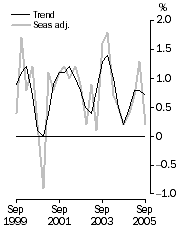
| Contributions to GDP growth, Expenditure - Seasonally adjusted
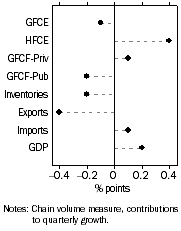
|
SEPTEMBER KEY POINTS
VOLUME GDP
- In trend terms, GDP increased 0.7% in the September quarter. GDP per capita grew by 0.3%, GDP per hour worked in the market sector increased by 0.3% and real net national disposable income grew by 1.5%.
- In seasonally adjusted terms, GDP increased by 0.2% in the September quarter. Non-farm GDP grew by 0.3%.
EXPENDITURE ON GDP
- In seasonally adjusted terms, the increase in expenditure on GDP reflected positive contributions from household consumption (+0.4 percentage points) and private business investment (+0.3 percentage points) offset by negative contributions from public investment (-0.2 percentage points), changes in inventories (-0.2 percentage points) and net exports (-0.3 percentage points).
INDUSTRY GROSS VALUE ADDED
- The strongest contributions were from construction and finance and insurance, offset by weaknesses in mining and agriculture.
NOTES
FEATURE ARTICLE
An article, 'Estimates of productivity in the Australian National Accounts' is being released with this publication and is available on the ABS web site <www.abs.gov.au>. An abstract is presented on page 14.
REVISIONS IN THIS ISSUE
Revisions have been made to a number of aggregates. The causes of the revisions fall into three categories:
- the quarterly series have been benchmarked to revised estimates from the annual supply and use tables for 1994-95 to 2003-04. To ensure continuity of time series, revisions to the supply and use tables have been applied over the full length of the dataset. The revised annual benchmarks were first published in the Australian System of National Accounts (cat. no. 5204.0) released on 7 November 2005. A feature article 'Updated national accounts annual benchmarks' was included in that release and provides details of the changes. The feature article is available on the ABS web site.
- the normal quarterly revisions due to the incorporation of more up-to-date source data
- the annual seasonal reanalysis that is undertaken on all series. This has caused revisions in all seasonally adjusted series to varying degrees.
There have also been changes to the sources and methods used to derive quarterly chain volume estimates of gross value added of the services to mining industry and the accommodation, cafes and restaurants industry. In both cases the new data source is the income from sales of goods and services from the Quarterly Business Indicator Survey (cat. no. 5767.0).
CHANGES IN THIS ISSUE
Changes have been made to some line items in the agricultural income (tables 23 and 61) to better reflect the valuation concepts used in the supply and use tables.
The taxes information reported in the general government income accounts (tables 37, 38 and 69) and in the tables showing details by type of tax (tables 39 and 72) has been changed to reflect the updated treatment of fringe benefit tax which is now classified as a tax on income rather than a tax on production.
Splits of machinery and equipment and non-dwelling construction have been introduced at the state level. Machinery and equipment has been split into 'new' and 'net purchases of second hand assets'. Non-dwellling construction has been split into 'new building', 'new engineering construction' and 'net purchases of second hand assets'. These new splits have been introduced in tables 76 to 107 which are available electronically.
INQUIRIES
For further information contact Patricia Mahony on Canberra (02) 6252 6711 for industry and income estimates, and Daniel Smith on Canberra (02) 6252 6713 for consumption, investment and trade estimates.
MAIN FEATURES EXPENDITURE CHAIN VOLUME MEASURES
 |  |  | Trend | Seasonally adjusted |  |
 |  |  | Quarterly % change Jun 05 to Sep 05 | Annual % change Sep 04 to Sep 05 | % points contribution to growth in GDP Jun 05 to Sep 05 | Quarterly % change Jun 05 to Sep 05 | Annual % change Sep 04 to Sep 05 | % points contribution to growth in GDP Jun 05 to Sep 05 |  |
|  |
| Final consumption expenditure |  |  |  |  |  |  |  |
 | General government | 0.2 | 2.1 | - | -0.6 | 1.6 | -0.1 |  |
 | Households | 0.6 | 2.8 | 0.4 | 0.6 | 2.7 | 0.4 |  |
| Gross fixed capital formation |  |  |  |  |  |  |  |
 | Private |  |  |  |  |  |  |  |
 |  | Dwellings | 1.0 | -0.7 | 0.1 | -0.5 | -1.4 | - |  |
 |  | Business investment | 3.1 | 14.5 | 0.4 | 2.0 | 17.0 | 0.3 |  |
 |  | Ownership transfer costs | -0.4 | -2.7 | - | -8.8 | -6.0 | -0.1 |  |
 | Public | -1.6 | 1.1 | -0.1 | -5.2 | 0.2 | -0.2 |  |
| Changes in inventories |  |  |  |  |  |  |  |
 | Private non-farm | . . | . . | -0.1 | . . | . . | -0.5 |  |
 | Farm and public authority | . . | . . | - | . . | . . | 0.2 |  |
| Gross national expenditure | 0.8 | 4.0 | 0.8 | - | 3.9 | - |  |
| Exports of goods and services | -0.1 | 2.2 | - | -2.3 | 2.6 | -0.4 |  |
| Imports of goods and services | 0.6 | 7.4 | -0.1 | -0.5 | 8.3 | 0.1 |  |
| Statistical discrepancy (E) | . . | . . | 0.1 | . . | . . | 0.5 |  |
| Gross domestic product | 0.7 | 2.8 | 0.7 | 0.2 | 2.6 | 0.2 |  |
|  |
| . . not applicable |
| - nil or rounded to zero (including null cells) |
SEPTEMBER QUARTER
Summary Comments
Final Consumption Expenditure
- In trend terms, household consumption increased by 0.6%. Seasonally adjusted growth was also 0.6%, with the main contributors to this growth being recreation and culture up 1.2%, food up 0.9% and clothing up 2.2%. Operation of vehicles fell by 2.4%. Government consumption increased by 0.2% in trend terms and fell by 0.6% seasonally adjusted due to falling state and local government expenditure.
Private gross fixed capital formation (GFCF)
- Trend private GFCF showed continued strength this quarter, up 2.2% (up 0.5% seasonally adjusted). Seasonally adjusted, increases in new engineering construction (up 5.8%) and new machinery and equipment (up 2.6%) were offset by falls in ownership transfer costs (down 8.8%) and alterations and additions (down 2.3%).
Changes in inventories
- Inventories increased by $875 million in trend terms and $507 million in seasonally adjusted terms. The seasonally adjusted change was mainly due to increases in manufacturing and retail trade inventories. This rise follows a larger rise in June quarter, thus the change in inventories detracted from seasonally adjusted GDP growth.
Exports and imports of goods and services
- Exports of goods and services fell by 0.1% in trend terms (down 2.3% seasonally adjusted). In seasonally adjusted terms exports of goods fell by 3.1% with the main contributor being non-rural exports (down 3.5%). Exports of services rose by 0.3% seasonally adjusted, mainly due to a rise in travel services.
- Imports of goods and services rose by 0.6% in trend terms (down 0.5% seasonally adjusted). Imports of goods fell 0.6% seasonally adjusted mainly due to falls in imports of intermediate and capital goods.
MAIN FEATURES PRODUCTION CHAIN VOLUME MEASURES
 | Trend | Seasonally adjusted |  |
 | Quarterly % change Jun 05 to Sep 05 | Annual % change Sep 04 to Sep 05 | % points contribution to growth in GDP Jun 05 to Sep 05 | Quarterly % change Jun 05 to Sep 05 | Annual % change Sep 04 to Sep 05 | % points contribution to growth in GDP Jun 05 to Sep 05 |  |
|  |
| Agriculture, forestry and fishing | -2.0 | -5.6 | -0.1 | -4.4 | -6.8 | -0.1 |  |
| Mining | 0.1 | 4.4 | - | -3.5 | 2.6 | -0.2 |  |
| Manufacturing | 0.5 | 0.9 | 0.1 | 0.4 | 1.4 | - |  |
| Electricity, gas and water supply | -0.4 | -0.5 | - | -2.8 | -2.1 | -0.1 |  |
| Construction | 2.2 | 7.2 | 0.1 | 1.8 | 7.4 | 0.1 |  |
| Wholesale trade | 0.5 | 3.2 | - | -0.6 | 3.7 | - |  |
| Retail trade | - | 1.3 | - | - | 0.5 | - |  |
| Accommodation, cafes and restaurants | 0.1 | -1.0 | - | 0.5 | -2.0 | - |  |
| Transport and storage | 0.1 | 2.8 | - | - | 3.3 | - |  |
| Communication services | 1.4 | 6.0 | - | 1.4 | 6.5 | - |  |
| Finance and insurance | 1.0 | 2.8 | 0.1 | 0.9 | 2.9 | 0.1 |  |
| Property and business services | - | -0.4 | - | -1.3 | -2.0 | -0.1 |  |
| Government administration and defence | 0.6 | 2.7 | - | 1.0 | 3.0 | - |  |
| Education | 0.3 | 1.2 | - | 0.3 | 1.2 | - |  |
| Health and community services | 0.4 | 3.2 | - | 0.3 | 3.3 | - |  |
| Cultural and recreational services | 3.5 | 9.5 | - | 5.0 | 9.6 | 0.1 |  |
| Personal and other services | 0.1 | 1.1 | - | 0.2 | 2.0 | - |  |
| Ownership of dwellings | 1.0 | 3.8 | 0.1 | 1.0 | 3.9 | 0.1 |  |
| Taxes less subsidies on products | - | 0.2 | - | -0.3 | -0.1 | - |  |
| Statistical discrepancy (P) | . . | . . | 0.2 | . . | . . | 0.2 |  |
| Gross domestic product | 0.7 | 2.8 | 0.7 | 0.2 | 2.6 | 0.2 |  |
|  |
| . . not applicable |
| - nil or rounded to zero (including null cells) |
SEPTEMBER QUARTER
Summary Comments
Agriculture, Forestry and Fishing
- The trend estimate fell 2.0% and the seasonally adjusted estimate was 4.4% lower. Agriculture, seasonally adjusted, decreased by 4.9% in the September quarter with a 16% increase in cereal grain production being more than offset by lower production of non-cereal crops, wool and livestock slaughterings. In annual terms, farm production for 2005-06 is projected to be at about the same level as in 2004-05 based on ABARE forecasts.
Manufacturing
- Increased by 0.5% in trend terms and by 0.4% in seasonally adjusted terms. Growth in seasonally adjusted terms was driven mainly by a 5.7% increase in machinery and equipment manufacturing.
Construction
- The trend estimate grew by 2.2% and the seasonally adjusted estimate was 1.8% higher. The main contributor to this growth was engineering construction.
Property and business services
- There was no change in growth in trend terms but the seasonally adjusted estimate fell by 1.3%. Activity was weaker in the business services industry.
Wholesale and Retail Trade
- Wholesale trade rose by 0.5% in trend terms but fell 0.6% in seasonally adjusted terms, while growth in the retail trade industry was unchanged in both trend and seasonally adjusted terms. For wholesale trade all indicators except personal and household goods were weaker. For the retail industry, the impact of the 0.5% growth in the ABS measure of retail turnover was directly offset by falls in the purchase and operation of motor vehicles.
MAIN FEATURES INCOME AT CURRENT PRICES
 |  | Trend | Seasonally adjusted |  |
 |  | Quarterly % change Jun 05 to Sep 05 | Annual % change Sep 04 to Sep 05 | % points contribution to growth in GDP Jun 05 to Sep 05 | Quarterly % change Jun 05 to Sep 05 | Annual % change Sep 04 to Sep 05 | % points contribution to growth in GDP Jun 05 to Sep 05 |  |
|  |
| Compensation of employees | 1.8 | 7.3 | 0.9 | 1.9 | 7.4 | 0.9 |  |
| Gross operating surplus |  |  |  |  |  |  |  |
 | Private | 4.0 | 16.8 | 0.7 | 2.6 | 17.6 | 0.5 |  |
 | Other | 2.2 | 8.3 | 0.3 | 1.8 | 8.4 | 0.3 |  |
| Gross mixed income | 0.7 | 1.0 | 0.1 | 0.9 | -0.1 | 0.1 |  |
| Taxes less subsidies on production and imports | 0.4 | 1.6 | - | -0.2 | -0.3 | - |  |
| Statistical discrepancy (I) | . . | . . | -0.2 | . . | . . | -0.7 |  |
| Gross domestic product | 1.8 | 7.4 | 1.8 | 1.0 | 7.1 | 1.0 |  |
|  |
| . . not applicable |
| - nil or rounded to zero (including null cells) |
SEPTEMBER QUARTER
Summary Comments
Compensation of employees
- The trend increase of 1.8% in the September quarter reflects a rise of 1.1% in average earnings and a 0.7% rise in the number of wage and salary earners. Seasonally adjusted, compensation of employees grew by 1.9%. Average earnings increased by 1.4%, while the number of wage and salary earners increased by 0.5%. Further discussion of compensation of employees is found on pages 10 and 11.
Wages(a) share of total factor income: Trend
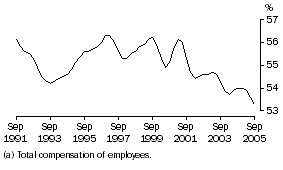
Gross operating surplus (GOS)
- The trend GOS of financial and non-financial corporations increased by 3.7% in the September quarter. Seasonally adjusted, GOS of financial and non-financial corporations increased by 2.7%, following an increase of 6.3% in the June quarter.
Profit(a) share of total factor income: Trend
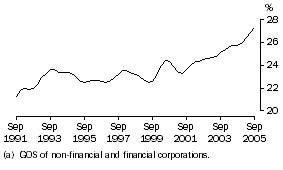
MAIN FEATURES STATE FINAL DEMAND CHAIN VOLUME MEASURES
 | Trend | Seasonally adjusted |  |
 | Quarterly % change Jun 05 to Sep 05 | Annual % change Sep 04 to Sep 05 | % points contribution to growth in DFD Jun 05 to Sep 05 | Quarterly % change Jun 05 to Sep 05 | Annual % change Sep 04 to Sep 05 | % points contribution to growth in DFD Jun 05 to Sep 05 |  |
|  |
| New South Wales | 0.3 | 2.7 | 0.1 | -0.8 | 2.3 | -0.3 |  |
| Victoria | 0.9 | 3.7 | 0.2 | 0.3 | 4.2 | 0.1 |  |
| Queensland | 1.4 | 4.2 | 0.3 | 1.9 | 4.1 | 0.3 |  |
| South Australia | 0.8 | 3.4 | 0.1 | -0.1 | 3.1 | - |  |
| Western Australia | 1.4 | 6.1 | 0.1 | 2.1 | 6.7 | 0.2 |  |
| Tasmania | 1.0 | 5.9 | - | 3.2 | 7.3 | 0.1 |  |
| Northern Territory | 1.7 | 13.2 | - | -2.2 | 13.6 | - |  |
| Australian Capital Territory | 0.4 | 0.8 | - | 1.2 | 0.3 | - |  |
| Australia (DFD)(a) | 0.8 | 3.8 | 0.8 | 0.2 | 3.8 | 0.2 |  |
|  |
| - nil or rounded to zero (including null cells) |
| (a) Domestic final demand. |
SEPTEMBER QUARTER
Summary Comments
State Final Demand
- In trend terms growth was strongest in the Northern Territory (up 1.7%). Lowest growth for the quarter occurred in New South Wales (up 0.3%). In seasonally adjusted terms Tasmania (up 3.2%) showed the strongest growth with the major contributors being household final consumption expenditure and private gross fixed capital formation. Seasonally adjusted growth was weakest in the Northern Territory (down 2.2%) due predominantly to a fall in private gross fixed capital formation.
Household final consumption expenditure
- In trend terms all states experienced growth, ranging from 1.7% in Tasmania and the Northern Territory to 0.3% in New South Wales. Growth in seasonally adjusted terms was also recorded in all states with Tasmania the highest (up 3.1%).
Government final consumption expenditure
- Trend growth in the September quarter was strongest in Queensland (up 0.7%) while the weakest growth was recorded in Tasmania (down 0.7%). In seasonally adjusted terms the strongest growth occurred in Queensland (up 1.2%) with Tasmania recording weakest growth (down 2.4%).
Private gross fixed capital formation
- In trend terms, the strongest growth was recorded in Tasmania and the Australian Capital Territory (each up 3.7%). Trend growth was lowest in New South Wales (up 1.5%). In seasonally adjusted terms strongest growth was recorded in Western Australia (up 12.8%) with weakest growth in the Northern Territory (down 10.6%).
- Seasonally adjusted investment in machinery and equipment increased in all states except the Northern Territory and New South Wales. Strongest growth was recorded in Western Australia (up 31.9%). Strongest growth in seasonally adjusted non-dwelling construction occurred in Victoria (up 14.4%) with weakest growth recorded in the Northern Territory (down 10.3%). Strong dwelling investment (seasonally adjusted) growth was recorded in Tasmania (up 21.7%) while the Northern Territory had the largest fall (down 6.9%).
Public gross fixed capital formation
- Trend growth was negative in all states, except for the Northern Territory and Queensland. Seasonally adjusted, strong growth was recorded in Queensland (up 16.3%), while Western Australia had the largest fall (down 27.5%).
ANALYSIS AND COMMENTS
GROWTH RATES IN GDP
The graph below provides a comparison of the quarterly growth rates for volume measures of GDP in both seasonally adjusted and trend terms over the last fourteen years. Following the fall in GDP (in seasonally adjusted volume terms) in December quarter 2000 there have been 19 consecutive quarters of growth.
Percentage changes, Chain volume measures
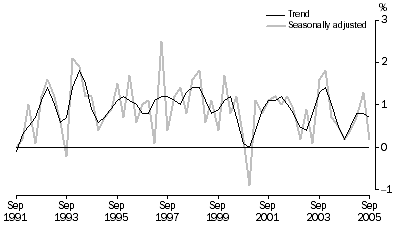
Growth (in trend volume terms) over the past four quarters has been driven by private investment in machinery and equipment (up 14.7%), new engineering construction (up 22.7%) and household final consumption expenditure (up 2.8%). Offsetting these was a strong rise in imports of goods and services (up 7.4%) and a fall in dwelling investment (down 0.7%).
On the industry side, the strongest contributors (in trend volume terms) over the past four quarters have been construction (up 7.2%) and finance and insurance (up 2.8%). Detracting from growth was a fall in agriculture, forestry and fishing (down 5.6%) and small declines in property and business services (down 0.4%) and accommodation, cafes and restaurants (down 1.0%).
REAL GROSS DOMESTIC INCOME
A measure of the real purchasing power of income generated by domestic production is the chain volume measure of GDP adjusted for the terms of trade effect, which is referred to as real gross domestic income (see Glossary for definition). The graph below provides a comparison of quarterly movements in trend GDP (volume measure) and real gross domestic income. During the September quarter, trend real gross domestic income increased by 1.4%, compared to the increase in the trend volume measure of GDP of 0.7%, reflecting a 2.0% improvement in the trend terms of trade. Trend and seasonally adjusted estimates of real gross domestic income are shown in tables 1 and 2.
Percentage changes, Trend
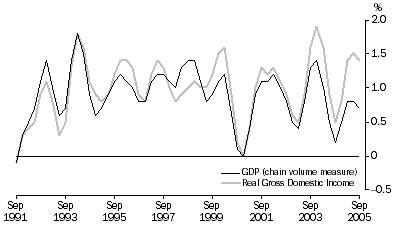
TERMS OF TRADE
The graph below shows the trend terms of trade (see Glossary for definition) over the past fourteen years. The very strong growth (up 27.8%) in the terms of trade since March quarter 2003 reflects a 14.0% growth in export prices and a 10.1% fall in import prices over the period. In September quarter 2005 the terms of trade rose 2.0% in trend terms, driven by a 2.8% rise in export prices.
Trend, (2003-04 = 100)
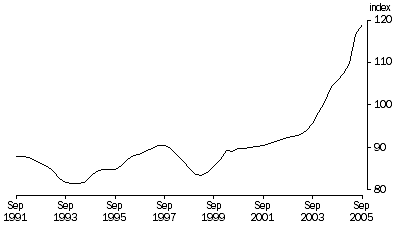
REAL NET NATIONAL DISPOSABLE INCOME
A broader measure of change in national economic well-being is real net national disposable income. This measure adjusts the volume measure of GDP for the terms of trade effect, real net incomes from overseas and consumption of fixed capital (see Glossary for definition). The graph below provides a comparison of quarterly movements in trend GDP (volume measure) and trend real net national disposable income. During the September quarter, trend real net national disposable income increased by 1.5%, while the increase in the trend volume measure of GDP was 0.7%.
Percentage changes, Trend
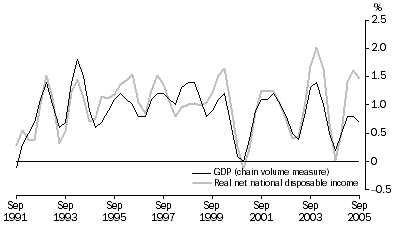
HOUSEHOLD SAVING RATIO
In both trend and seasonally adjusted terms the household saving ratio (see Glossary for definition) was negative in September quarter 2005, implying that household consumption was greater than household disposable income. In trend terms the ratio was -2.5% in September quarter 2005 and in seasonally adjusted terms it was -2.1%. The following graph presents the household saving ratio derived from trend and seasonally adjusted data.
Household saving ratio, Current prices
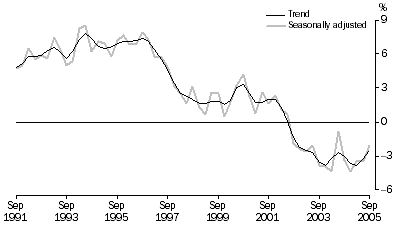
Although seasonally adjusted household saving has been negative over the past three years, net national saving has been positive over the same period. The national net saving ratio in the September quarter 2005 was 7.5% in seasonally adjusted terms.
Caution should be exercised in interpreting the household saving ratio in recent years, because major components of household income and expenditure may still be subject to significant revisions. The impact of these revisions on the saving ratio can cause changes in the apparent direction of the trend.
COMPENSATION OF EMPLOYEES
In September quarter 2005, seasonally adjusted compensation of employees grew by 1.9%, while the seasonally adjusted number of employees recorded in the Labour Force survey grew by 0.5%. Thus, average compensation per employee increased by 1.4%. This follows growth of 0.9% and 0.7% in the March quarter 2005 and June quarter 2005 respectively. The annual 2004-05 growth rate was 3.5% compared to 3.8% growth over the same period in the total hourly rates of pay, excluding bonuses as published in Labour Price Index, Australia (cat. no. 6345.0). (It should be noted that the conceptual bases for the two wage measures are different.)
PRIVATE NON-FARM INVENTORIES TO TOTAL SALES RATIO
In trend current price terms, the book value of private non-farm inventories increased by $1,763 million (1.7%) in September quarter 2005, while total sales rose by $3,590 million (2.5%). Consequently, the trend inventories to total sales ratio (see Glossary for definition) decreased from 0.750 in the June quarter 2005 to 0.743 in September quarter 2005. The following graph presents the ratio of private non-farm inventories to total sales over the last fourteen years.
Trend, Current prices
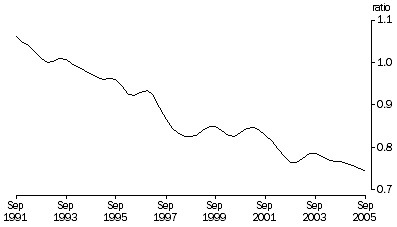
IMPORTS TO DOMESTIC SALES
The imports to domestic sales ratio (see Glossary for definition), trended and at current prices, remained at 0.344. This reflects a rise of 1.4% in imports of goods accompanied by a 1.6% rise in domestic sales. The following graph presents the ratio of imports to domestic sales over the last fourteen years.
Trend, Current prices
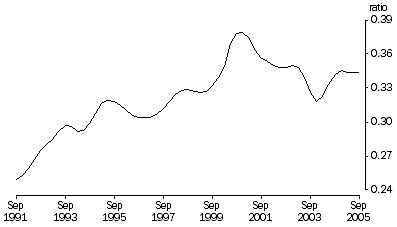
RATIO OF CURRENT ACCOUNT TO GDP
The table below shows the current account deficit to GDP ratio for the past six quarters. In September quarter 2005, the current account deficit represented 6.3% of GDP. For a complete time series of this table, please refer to Table 35 in Balance of Payments and International Investment Position, Australia (cat. no. 5302.0) which was released on AusStats in conjunction with the release of this issue of the quarterly national accounts.
Ratios of current account measures to GDP(a) |
|  |
 |  | Jun Qtr 2004 | Sep Qtr 2004 | Dec Qtr 2004 | Mar Qtr 2005 | Jun Qtr 2005 | Sep Qtr 2005 |  |
$ Million |  |
|  |
| GDP | 212 765 | 216 509 | 230 910 | 215 909 | 229 185 | 232 436 |  |
Ratios to GDP (percentage) |  |
|  |
| Current account | -5.6 | -5.9 | -6.3 | -6.5 | -6.4 | -6.3 |  |
| Goods and services | -2.7 | -2.8 | -3.0 | -3.0 | -2.8 | -2.5 |  |
 | Credits | 17.3 | 17.5 | 17.8 | 18.1 | 18.4 | 18.7 |  |
 | Debits | -20.0 | -20.3 | -20.8 | -21.1 | -21.2 | -21.2 |  |
| Income | -2.8 | -3.0 | -3.3 | -3.5 | -3.6 | -3.7 |  |
| Net international investment position | 56.1 | 57.8 | 58.5 | 58.8 | 59.1 | 59.3 |  |
 | Net foreign equity | 9.0 | 9.9 | 9.7 | 10.2 | 10.1 | 9.8 |  |
 | Net foreign debt | 47.1 | 47.9 | 48.7 | 48.6 | 49.0 | 49.5 |  |
|  |
| (a) Derived from current price original data. The net international investment position ratios are derived from the net foreign liabilities at the end of the period and GDP for the year ended with that period. Other ratios are derived using data for the year ended with the period shown. |
RELIABILITY OF CONTEMPORARY TREND ESTIMATES
Trend estimates are used throughout this publication as an alternative approach to the analysis of movements in time series data. Further details regarding the procedures used to estimate the trend series are described in the Explanatory Notes (paragraphs 13 - 17) and in Information Paper: A Guide to Interpreting Time Series - Monitoring Trends, 2003 (cat. no. 1349.0) released in August 2003.
Potential revisions to trend estimates can be indicated by showing the effects of particular changes in seasonally adjusted estimates that might occur in the next quarter. The table below shows the trend estimates for the last ten quarters and the values to which they would be revised if the given movements in seasonally adjusted GDP actually occurred in December quarter 2005. Seasonally adjusted growth of 1.0% is required in December quarter 2005 to maintain, in December quarter 2005, the trend growth of 0.7% currently estimated for the September quarter 2005.
Percentage change in GDP Chain volume measure |
|  |
 |  |  |  | Trend estimate if seasonally adjusted GDP changes by the following amounts in December qtr 2005 |  |
 |  | Seasonally adjusted GDP as published in table 2 | Trend GDP as published in table 1 | Grows by 1.0% | No change | Falls by 1.0% |  |
|  |
| 2003 |  |  |  |  |  |  |
 | June | 0.1 | 0.8 | 0.8 | 0.8 | 0.8 |  |
 | September | 1.6 | 1.3 | 1.3 | 1.3 | 1.3 |  |
 | December | 1.8 | 1.4 | 1.4 | 1.4 | 1.4 |  |
| 2004 |  |  |  |  |  |  |
 | March | 0.7 | 1.0 | 1.0 | 1.0 | 1.0 |  |
 | June | 0.5 | 0.5 | 0.5 | 0.5 | 0.5 |  |
 | September | 0.2 | 0.2 | 0.2 | 0.2 | 0.2 |  |
 | December | 0.4 | 0.5 | 0.5 | 0.5 | 0.5 |  |
| 2005 |  |  |  |  |  |  |
 | March | 0.7 | 0.8 | 0.7 | 0.8 | 0.9 |  |
 | June | 1.3 | 0.8 | 0.8 | 0.7 | 0.7 |  |
 | September | 0.2 | 0.7 | 0.7 | 0.5 | 0.2 |  |
|  |
 Print Page
Print Page
 Print All
Print All